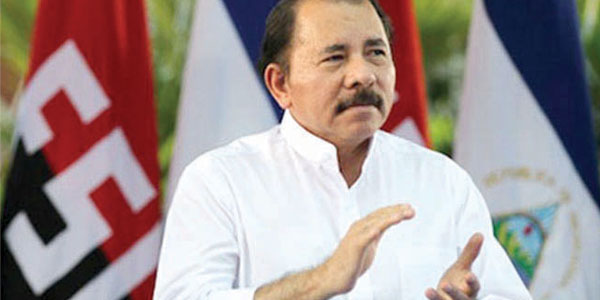
There are two things I don’t understand about Daniel Ortega, Nicaragua’s president. The first is why he so wants to be like Anastasio Somoza Debayle, the tyrant he tirelessly fought to overthrow decades ago during the country’s civil war; the second is why he lives in a house that isn’t his.
A bit more on the house later, but let me begin with the recent unrest in Nicaragua. What started as demonstrations against changes to social programs quickly turned into a revolt against Ortega and Rosario Murillo, his wife and the vice president. The regime has a strong grip on the country, and Ortega has now ruled for 23 years — from 1979 to 1990, and from 2006 to the present.
Government repression against protesters, who are mostly young people and students, has been brutal. The death toll has surpassed 40 in the last month, according to the Nicaraguan Human Rights Center.
Among the dead was the journalist Ángel Gahona, who was killed while reporting on the protests in Bluefields, Nicaragua, last month. His wife, Migueliuth Sandoval, who was watching Gahona on Facebook Live, saw his killing. “It was the work of a sniper,” Sandoval said. “He was shot right at the temple.” (Listen to my interview with Gahona’s wife and son on my podcast: bit.ly/2JLs857.)
And who ordered the crackdown? “The absent ruler and his ubiquitous vice president not only tried to discredit the protests,” wrote the Nicaraguan journalist Carlos Fernando Chamorro in the magazine Confidencial, “but also ordered the crackdown to intensify repression to the point where they actually caused a massacre.” This has been, according to Chamorro, “the worst bloodshed in the history of Nicaragua during the postwar years.”
Ortega, once a Sandinista revolutionary, is now emulating the methods of the dictatorship he helped overthrow. And he has taken on the same sense of impunity. There is no hope of putting the masterminds of this carnage behind bars.
The revolt against Ortega and his regime was born in Nicaragua itself. It’s not an international conspiracy intended to “disrupt” the country, as Cuba’s dictators have recently suggested. These are students and teenagers who are sick of censorship and murder and are tired of living under an authoritarian government.
These young Nicaraguans remind me a lot of the “Dreamers” and the survivors of the Parkland High School massacre in Florida. Change in Nicaragua is in the hands of the next generation, and they must know that they are not alone. Official censorship is largely evaded through social media, so we have been able to hear and see what’s happening to them. Tyrants cannot hide the truth. Images of repression in Nicaragua will remain on the internet forever.
If something has been made clear amid this unrest, it is that the future of Nicaragua has no place for the Ortega regime. The country has gone through many decades of dictatorship, and the current regime’s 23-year rule has been more than long enough. As we have seen in the streets, a new generation has emerged and is ready to lead the country.
Now, about that house where Ortega and Murillo live. It’s not theirs. They took the estate from the Morales Carazo family, who were outside the country during the Sandinista Revolution in 1979. Jaime Morales, the former owner, told me some time ago that it was illegally seized. Morales, who later made peace with Ortega (and even became his vice president), estimated that when it was seized from him, the house and its contents were worth $1 million to $2 million.
I spoke with Ortega in 1996, and he actually couldn’t tell me how much he paid for the house. “It was a very small amount, because everything was undervalued at the time,” he said, without elaborating further. “I have hung onto the house; it’s a symbol.”
That’s right. The house is a symbol — and a reward. We should’ve known: If Ortega and Murillo didn’t have any problems hanging on to a house that wasn’t theirs, obviously they wouldn’t have any problems hanging on to a country that wasn’t theirs either.
It’s time to move out.
Nicaragua has woken up, and the perpetrators of this massacre must be investigated. And Ortega and Murillo should start looking for a new house.
Hay dos cosas que nunca he entendido del presidente Daniel Ortega. Una es por qué se quiere parecer al tirano que luchó tanto por derrocar: Anastasio Somoza Debayle. La otra es por qué vive en una casa que no es suya.
Les cuento la increíble historia de la casa más adelante pero déjenme comenzar con las recientes protestas en Nicaragua. Lo que empezó como manifestaciones por los cambios en programa sociales rápidamente se convirtió en una revuelta contra el régimen de Ortega y Rosario Murillo, su esposa y vicepresidente. Ellos tienen un duro control sobre el país. Y lejos de ser un demócrata, Ortega lleva 23 años en el poder en total (de 1979 a 1990, y del 2006 al 2018).
La represión de su gobierno contra los manifestantes — jóvenes y estudiantes en su mayoría — fue brutal. La cifra de muertos, según el Centro Nicaragüense de Derechos Humanos, ya superó los 40.
¿Quién ordenó esa matanza? “El gobernante ausente y su omnipresente vicepresidente no solamente intentaron descalificar la protesta”, escribió desde Managua el periodista Carlos Fernando Chamorro en la revista Confidencial, “sino que ordenaron arreciar la represión hasta provocar una verdadera masacre”. Se trata, en palabras de Chamorro, en “el peor baño de sangre de la historia de Nicaragua en los años de posguerra”.
El antiguo revolucionario sandinista copia los mismos métodos represivos de la dictadura que derrocó. Y la impunidad. No hay ninguna esperanza de meter a la cárcel a los autores intelectuales de la matanza.
Entre los muertos estaba el periodista Ángel Gahona, quien reportaba en vivo (en Facebook Live) las protestas en la población de Bluefields, Nicaragua. Su esposa, quien seguía la transmisión, vio cómo murió: “Fue un disparo profesional”, me dijo Migueliuth Sandoval. “Fue un disparo en la sien, que no cualquier acierta”. (Aquí pueden escuchar el podcast de mi entrevista con la esposa y el hijo de Gahona: bit.ly/2JLs857 )
La revuelta contra Ortega y su clan surgió desde dentro de Nicaragua. No se trata de ninguna conspiración internacional para “desestabilizar” el país, como sugirió perversamente la dictadura cubana. Se trata de estudiantes y adolescentes que han perdido el miedo y que están hartos de tener un gobierno autoritario, uno que censura y mata.
Estos jóvenes nicaragüenses me recuerdan tanto a los “Dreamers” y a los alumnos sobrevivientes de la masacre en la escuela secundaria de Parkland en la Florida. El cambio en Nicaragua está en sus manos. Y deben saber que no están solos; que fuera de Nicaragua los oímos y los vemos. La censura oficial fue ampliamente burlada a través de Twitter, Facebook e Instagram. Los tiranos ya no pueden ocultar lo que ocurre. Los videos de la represión vivirán para siempre en la internet.
Si algo quedó muy claro luego de las protestas es que el futuro de Nicaragua es sin los Ortega-Murillo. Nicaragua ha vivido muchas décadas de dictadura y 23 años de Ortega en el poder son más que suficiente. Como vimos en las calles, ya hay una nueva generación lista para liderar al país.
Y termino con la historia de la casa — con un terreno de 4 mil metros cuadrados — donde viven Ortega y su esposa. No es su casa. Se la arrebataron a la familia Morales Carazo, que estaba de viaje tras el triunfo de la revolución sandinista en 1979, y fue confiscada ilegalmente, según me contó hace tiempo su dueño. Jaime Morales (quien luego, sorprendentemente, hizo las paces con Ortega y hasta fue su vicepresidente) calculaba que, cuando se la quitaron, la casa valía entre $1.5 millón y $2 millones de dólares (incluyendo seis fuentes, seis cuartos y las obras de arte).
En una entrevista en 1996, Ortega no me pudo decir cuánto pagó por esa casa. “Fue una suma muy pequeña porque en ese tiempo todo estaba subvaluado”, me dijo, sin dar más detalles. “Yo me he aferrado a la casa [por ser] un símbolo”.
Exacto. Esa casa fue un símbolo y una premonición. Debimos saberlo. Si Ortega y Murillo no tuvieron ningún problema en apropiarse de una casa que no era suya, tampoco tendrían ningún problema en apropiarse de un país que no era suyo.
Es hora de la mudanza. Nicaragua se despertó. Hay que investigar a los asesinos de la masacre y adelantar las elecciones presidenciales. Y Ortega y Murillo se tienen que poner a buscar casa nueva. (Jorge Ramos, periodista ganador del Emmy, es el principal director de noticias de Univision Network. )










